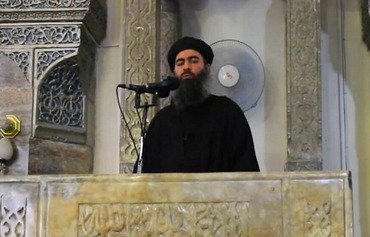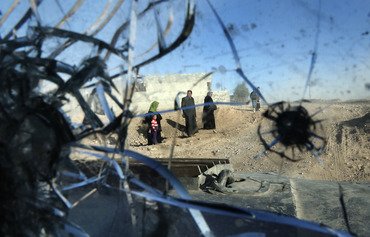Iraqi forces supported by the international coalition have killed a group of first- and second-tier "Islamic State of Iraq and Syria" (ISIS) leaders in an airstrike against their stronghold on the Syrian border, an Iraqi official said.
Among them are Ibrahim Shalal Maydan al-Zawbaie, ISIS leader Abu Bakr al-Baghdadi's father-in-law, who is considered to be his right-hand man.
Other senior ISIS leaders killed in the strike have been named by a local official as Abdul Wahhab Mutayr al-Dulaifi, Arif Mahalif Hussein al-Fahdawi and Khalid Ayed Jassim Mohammed al-Zawi.
"Iraqi intelligence is continuing its pursuit of the remaining ISIS elements in the western regions of the country, especially along the border with Syria," security expert Saeed al-Jayashi told Diyaruna on Thursday (August 16th).
![Iraqi officers track the movement of ISIS elements deep in Iraq's western desert in this photo, posted online on August 11th. [Photo courtesy of Iraqi Border Guards]](/cnmi_di/images/2018/08/16/14043-Iraqi-officers-border-600_384.jpg)
Iraqi officers track the movement of ISIS elements deep in Iraq's western desert in this photo, posted online on August 11th. [Photo courtesy of Iraqi Border Guards]
The group has been attempting to hold meetings in the border area or on Syrian territory near Iraq, he said.
"When information comes in from the Hawks Intelligence Cell about a gathering of terrorists, the target is accurately identified and a strike is carried out against them in co-ordination between the Iraqi air force and coalition aircraft," he said.
Many leaders have been killed in the recent barrage of strikes, known as Operation Roundup, which began May 1st in the border region and the Middle Euphrates River Valley continues to gain ground.
Between August 6th and August 12th, coalition forces conducted 12 strikes in Iraq and Syria, the international coalition announced Monday.
In addition to the casualties inflicted on the group, the strikes destroyed a supply route and a number of weapons caches, buildings, tunnels, caves and vehicles used by the group, the coalition said.
Iraqi authorities are expected to confirm the identities of the slain leaders in a video message within the next 48 hours, al-Jayashi said.
He gave no further details, but stressed that the killing of the ISIS leaders "is a great loss for ISIS, as they are first- and second-tier leaders in the organisation, including senior leaders and field commanders".
Shrinking media presence
ISIS has been attempting to restore itself in the media as its own media output and activity has dropped by about 70% compared to its previous levels, al-Jayashi said.
Much of the "news" produced by ISIS's al-Amaq agency is simply "not true", he added, accusing the group of "promoting lies to create the illusion that its field and psychological impact still exists".
"The size of the organisation as portrayed in its media is one thing, and its size on the ground is something else altogether," he said.
As for the possibility that ISIS leader al-Baghdadi was himself killed in the latest attack, "that is unlikely", al-Jayashi said.
"Al-Baghdadi has been targeted more than once and is still a key target of Iraqi intelligence," he said, noting that intelligence services "are on alert to search for any information leading to his whereabouts".
As is the case with many extremist groups, ISIS adheres to a system of allegiance, he explained, meaning that when their leader is eliminated, they do not hide it, and quickly declare allegiance to another leader.
"Al-Baghdadi may very well be wounded," he said. "But his death could not be hidden, as a replacement must be presented quickly so that the organisation's different units can continue to work, or it might break apart."

![Iraqi military units are seen positioning themselves to carry out an assault on an ISIS stronghold near the border with Syria in this photo, posted online on August 11th. [Photo courtesy of Iraqi Border Guards]](/cnmi_di/images/2018/08/16/14042-Iraqi-military-border-600_384.jpg)






